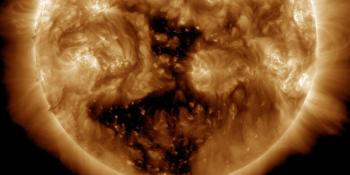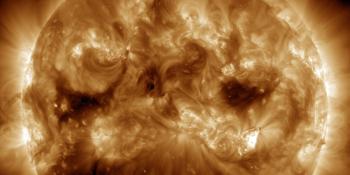Viewing archive of Saturday, 8 February 2014
Geophysical report
Any mentioned solar flare in this report has a scaling factor applied by the Space Weather Prediction Center (SWPC). Because of the SWPC scaling factor, solar flares are reported as 42% smaller than for the science quality data. The scaling factor has been removed from our archived solar flare data to reflect the true physical units.
Solar and Geophysical Activity Summary 2014 Feb 08 0245 UTCPrepared by the NOAA © SWPC and processed by SpaceWeatherLive.com
Joint USAF/NOAA Solar and Geophysical Activity Summary
SGAS Number 039 Issued at 0245Z on 08 Feb 2014 This report is compiled from data received at SWO on 07 FebA. Energetic Events
Begin Max End Rgn Loc Xray Op 245MHz 10cm Sweep 0339 0339 0339 140 0447 0456 0504 1967 S15W50 M2.0 2n 0644 0644 0644 110 1025 1029 1031 1968 N09W53 M1.9 1n
B. Proton Events
None.
C. Geomagnetic Activity Summary
The geomagnetic field was at quiet
to active levels.
D. Stratwarm
Not available
E. Daily Indices: (real-time preliminary/estimated values)
10 cm 178 SSN 241 Afr/Ap 007/006 X-ray Background C1.2 Daily Proton Fluence (flux accumulation over 24 hrs) GT 1 MeV 2.1e+05 GT 10 MeV 1.0e+04 p/(cm2-ster-day) (GOES-13 satellite synchronous orbit W74 degrees) Daily Electron Fluence GT 2 MeV 3.80e+05 e/(cm2-ster-day) (GOES-13 satellite synchronous orbit W74 degrees) 3 Hour K-indices Boulder 0 0 1 2 2 3 3 3 Planetary 0 0 1 2 1 2 2 3
F. Comments
None.
All times in UTC
Current data suggests there is a slight possibility for aurora to appear at the following high latitude regions in the near future
Fairbanks, AKLatest news
Latest forum messages
AR4043 26Incoming & Unnumbered Active Regions 1649Large Coronal Hole 25 177Photographing auroras 37Countdown Timer? 9
More topicsSupport SpaceWeatherLive.com!
A lot of people come to SpaceWeatherLive to follow the Sun's activity or if there is aurora to be seen, but with more traffic comes higher server costs. Consider a donation if you enjoy SpaceWeatherLive so we can keep the website online!

Latest alerts
Thursday, 27 March 2025
16:15 UTC - Geomagnetic activity
Minor G1 geomagnetic storm (Kp5) Threshold Reached: 16:05 UTC
15:15 UTC - Geomagnetic activity
Minor G1 geomagnetic storm (Kp5) Threshold Reached: 14:59 UTC
09:15 UTC - Geomagnetic activity
Minor G1 geomagnetic storm (Kp5) Threshold Reached: 08:59 UTC
06:27 UTC - Hemispheric Power Index
The OVATION model predicts the Hemispheric Power Index to reach 54GW at 07:01 UTC
06:00 UTC - Geomagnetic activity
Minor G1 geomagnetic storm (Kp5) Threshold Reached: 05:51 UTC
Space weather facts
| Last X-flare | 2025/02/23 | X2.0 |
| Last M-flare | 2025/03/27 | M2.0 |
| Last geomagnetic storm | 2025/03/27 | Kp5 (G1) |
| Spotless days | |
|---|---|
| Last spotless day | 2022/06/08 |
| Monthly mean Sunspot Number | |
|---|---|
| February 2025 | 154.6 +17.6 |
| March 2025 | 130 -24.6 |
| Last 30 days | 130 -22.2 |





